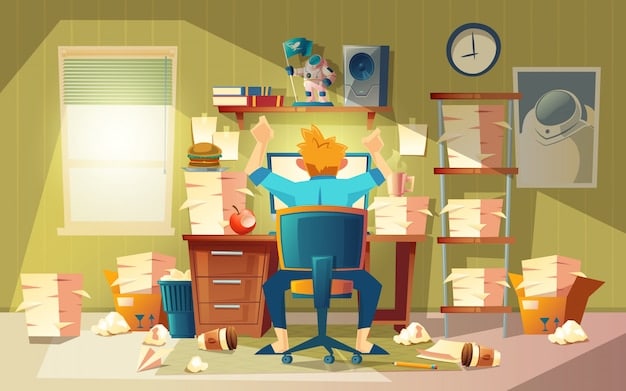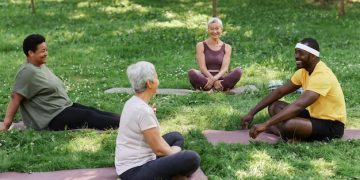Reduce Anxiety: 5 Proven Stress Management Techniques

Managing stress effectively involves employing practical techniques such as mindfulness, exercise, proper sleep, social connection, and time management that can significantly reduce anxiety levels, aiming for a 10% reduction in anxiety within a month.
Feeling overwhelmed? You’re not alone. Managing stress: 5 practical techniques to reduce anxiety by 10% this month is achievable by incorporating simple, yet effective strategies into your daily life. Let’s explore how.
Understanding Stress and Anxiety
Stress and anxiety are common experiences in today’s fast-paced world, but understanding the difference is the first step towards effectively managing them. While stress is often triggered by external pressures, anxiety can be a more persistent feeling of worry or unease.
Recognizing the sources of your stress and anxiety is crucial. It allows you to tailor your approach to each situation, making you better equipped to handle challenges as they arise. Understanding the root cause empowers you to take control and implement healthy coping mechanisms.
Identifying Your Stress Triggers
Pinpointing specific triggers can make managing stress more manageable. Some common triggers include work-related pressures, financial worries, relationship issues, and health concerns. However, everyone’s triggers are unique.
The Difference Between Stress and Anxiety
While often used interchangeably, stress and anxiety have distinct characteristics. Stress is generally short-term and triggered by a specific event, while anxiety is a prolonged feeling of worry that can persist even when there is no immediate threat.
- Stress: Triggered by specific events, short-term, and dissipates when the stressor is removed.
- Anxiety: Persistent worry, can occur without specific triggers, and may require more long-term management strategies.
- Symptoms Overlap: Both can manifest as physical symptoms such as headaches, muscle tension, and difficulty sleeping.

In summary, understanding stress and anxiety involves recognizing the unique triggers and characteristics of each. By identifying your personal triggers and knowing the difference between short-term stress and persistent anxiety, you can better tailor your approach to effectively manage your mental well-being.
Technique 1: Mindfulness Meditation
Mindfulness meditation is a powerful tool for reducing anxiety by focusing on the present moment. It involves training your mind to observe thoughts and feelings without judgment, fostering a sense of calm and centeredness.
Through regular practice, mindfulness meditation can help you become more aware of your mental and emotional state. This heightened awareness enables you to respond to stressors with greater clarity and composure, rather than reacting impulsively.
How to Practice Mindfulness Meditation
Start with a quiet space where you won’t be disturbed. Sit comfortably, close your eyes, and focus on your breath. When your mind wanders, gently redirect your attention back to your breath.
Benefits of Regular Practice
Regular mindfulness meditation can lead to a significant reduction in anxiety levels. It can also improve focus, emotional regulation, and overall mental well-being. Consistent practice is key to experiencing these benefits.
- Reduced Anxiety: Calms the mind and reduces feelings of worry.
- Improved Focus: Enhances concentration and attention span.
- Emotional Regulation: Helps manage and regulate emotions effectively.
In conclusion, mindfulness meditation is a practical technique that can significantly reduce anxiety by promoting present moment awareness and emotional regulation. Regular practice can lead to improved mental well-being and a greater ability to manage stress effectively.
Technique 2: Regular Physical Exercise
Engaging in regular physical exercise is a highly effective way to manage stress and reduce anxiety. Exercise releases endorphins, which are natural mood boosters that can alleviate feelings of stress and improve overall mental well-being.
Moreover, physical activity provides a healthy distraction from daily stressors, allowing you to clear your mind and recharge. Whether it’s a brisk walk, a gym workout, or a yoga session, finding an activity you enjoy can make a significant difference.
Choosing the Right Exercise
The key to sticking with an exercise routine is to choose activities you find enjoyable. Whether it’s running, swimming, dancing, or team sports, find something that motivates you to stay active.
The Impact of Endorphins
Endorphins act as natural pain relievers and mood elevators. They interact with receptors in the brain to reduce perception of pain and trigger a positive feeling in the body, similar to that of morphine.
- Endorphin Release: Exercise triggers the release of endorphins, natural mood boosters.
- Distraction from Stress: Provides a healthy distraction from daily worries.
- Improved Sleep: Regular physical activity promotes better sleep patterns.
In summary, regular physical exercise is a valuable technique for managing stress and reducing anxiety. By releasing endorphins and providing a healthy distraction, exercise can significantly improve your mental and physical well-being. Finding an enjoyable activity and making it a part of your routine is essential for long-term stress management.
Technique 3: Prioritizing Sleep Hygiene
Prioritizing sleep hygiene is crucial for managing stress and reducing anxiety. Adequate sleep allows your body and mind to rest and recover, enhancing your ability to cope with daily stressors. A consistent sleep schedule and a relaxing bedtime routine can significantly improve your sleep quality.
Establishing healthy sleep habits can have a profound impact on your overall mental health. Lack of sleep can exacerbate feelings of anxiety and make it harder to manage stress effectively. By making sleep a priority, you can enhance your resilience and improve your emotional well-being.
Creating a Relaxing Bedtime Routine
A calming bedtime routine can signal to your body that it’s time to sleep. This might include taking a warm bath, reading a book, or practicing relaxation techniques like deep breathing or meditation.
Maintaining a Consistent Sleep Schedule
Going to bed and waking up at the same time each day, even on weekends, helps regulate your body’s natural sleep-wake cycle. This consistency can lead to more restful and rejuvenating sleep.
- Consistent Schedule: Maintains the body’s natural sleep-wake cycle.
- Relaxing Routine: Signals to the body that it’s time to sleep.
- Improved Recovery: Allows the body and mind to rest and recover.

In conclusion, prioritizing sleep hygiene is a fundamental technique for managing stress and reducing anxiety. By creating a relaxing bedtime routine and maintaining a consistent sleep schedule, you can improve your sleep quality and enhance your overall mental well-being. Ensuring you get adequate rest is essential for building resilience and effectively coping with daily stressors.
Technique 4: Cultivating Social Connections
Cultivating social connections is a vital component of managing stress and reducing anxiety. Strong relationships provide a sense of belonging and support, which can buffer against the negative effects of stress. Engaging with friends and family can offer emotional comfort and a valuable perspective on your challenges.
Social interaction helps release oxytocin, often referred to as the “love hormone,” which promotes feelings of connection and reduces stress. Making time for meaningful interactions can significantly improve your mood and overall mental well-being.
The Importance of Support Systems
Having a strong support system allows you to share your feelings and experiences with others who care about you. This can provide a sense of validation and help you feel less alone in your struggles.
Engaging in Social Activities
Participating in social activities, whether it’s joining a club, volunteering, or simply spending time with friends, can boost your mood and reduce feelings of isolation. These activities offer opportunities to connect with others and build meaningful relationships.
- Emotional Support: Provides comfort and a sense of belonging.
- Oxytocin Release: Promotes feelings of connection and reduces stress.
- Reduced Isolation: Helps combat feelings of loneliness and enhances mood.
In summary, cultivating social connections is an important technique for managing stress and reducing anxiety. By building strong relationships and engaging in social activities, you can foster a sense of belonging and gain valuable emotional support. Prioritizing social interaction can significantly improve your mental well-being and resilience.
Technique 5: Effective Time Management
Effective time management is an essential skill for managing stress and reducing anxiety. By organizing your tasks and setting realistic goals, you can reduce feelings of overwhelm and increase your sense of control. Prioritizing tasks and breaking them down into manageable steps can make even the most daunting projects feel achievable.
Good time management techniques can help you create a more balanced and structured schedule, reducing the likelihood of procrastination and last-minute stress. This, in turn, can lead to improved productivity and a greater sense of accomplishment.
Prioritizing Tasks
Identify your most important tasks and focus on completing them first. This ensures that you are making progress on what matters most and reduces the stress of feeling behind. The Eisenhower Matrix (urgent/important) is a helpful tool for this.
Breaking Down Large Projects
Large projects can feel overwhelming if you try to tackle them all at once. Break them down into smaller, more manageable steps, and focus on completing one step at a time. This makes the project feel less daunting and more achievable.
- Reduced Overwhelm: Organizing tasks can reduce feelings of being overwhelmed.
- Increased Control: Helps you feel more in control of your time and responsibilities.
- Improved Productivity: Leads to greater efficiency and a sense of accomplishment.
In conclusion, effective time management is a valuable technique for managing stress and reducing anxiety. By prioritizing tasks, breaking down large projects, and creating a balanced schedule, you can reduce feelings of overwhelm and increase your sense of control. Implementing these strategies can lead to improved productivity and a greater sense of accomplishment, ultimately enhancing your mental well-being.
| Key Point | Brief Description |
|---|---|
| 🧘 Mindfulness | Focus on the present moment to reduce anxiety. |
| 💪 Exercise | Releases endorphins, boosting mood and reducing stress. |
| 😴 Sleep Hygiene | Prioritize consistent and restful sleep. |
| 🫂 Social Connection | Cultivate relationships for emotional support. |
Frequently Asked Questions
▼
Results vary, but many people experience noticeable reductions within a month by consistently practicing these techniques. Mindfulness, exercise, and improved sleep can have a relatively quick positive impact.
▼
Start with one or two techniques that resonate most with you. Even small changes can make a difference. Gradually incorporate others as you find time and see positive results.
▼
These techniques can be helpful for managing mild to moderate anxiety. However, if you’re experiencing severe anxiety or it’s significantly impacting your life, seek professional help from a therapist or counselor.
▼
Schedule time for each technique in your daily or weekly routine. Make it a priority and track your progress. Find an accountability partner or join a group to stay motivated and consistent.
▼
Mindfulness takes practice. Start with short sessions (5-10 minutes) and gradually increase the duration. Use guided meditations or apps to help you focus. Be patient and kind to yourself.
Conclusion
Incorporating these five practical techniques – mindfulness meditation, regular physical exercise, prioritizing sleep hygiene, cultivating social connections, and effective time management – into your daily routine can significantly reduce anxiety levels and improve your overall mental well-being. Remember, consistency is key, and even small changes can lead to substantial improvements over time. Start with one or two techniques that resonate with you and gradually integrate others. If you’re seeking more support, don’t hesitate to reach out to a professional. Taking proactive steps to manage your stress and anxiety is an investment in your long-term health and happiness.





